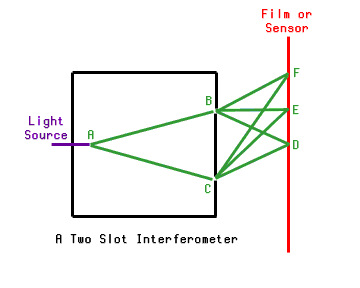 |
One interpretation of a photon, a particle of light, is as a perpetually collapsing electric or magnetic field. Whenever an electric field collapses, it induces a nearby magnetic field. When the original electric field is entirely gone, the magnetic field starts to fail, which in turn creates a new electric field. The result is a ripple effect, traveling through space. At the speed of light, a series of fields come into existence, then face, positive electric, south magnetic, negative, north, positive, south, etc...
And yet, should the series of waves strike a solid object, it has momentum. The object that is struck will be pushed, however slightly. Photons are both waves and particles. As it turns out, all particles have both wavelength and momentum. All particles have a dual nature, though the alternating electric and magnetic fields of a photon make the wave aspects more accessible than others.
 |
The above diagram shows a simple interferometer. Assume the light source generates many photons, all in phase, and all of the same wavelength, the same color. Thus, at any given moment, all photons leaving the light source have their energy in the same aspect, for example positive electric. The photons have two paths to reach point D, through the holes B and C in the interferometer box. The paths are ABD and ACD. Both paths are of equal length. Thus, if the photons left the A in phase, they should arrive at D in phase. The fields of the two sets of photons, taking either path, would be in phase at D, the field strength would add together. Thus, there would be a bright spot at and near D.
There will be a point E such that ABE and ACE are different by half the wave length of the particles. That is, the photons traveling through ABE might arrive as positive electric energy, while the ACE photons arrive as negative electric. The two sets of photons cancel each other. Point E and the nearby region will be dark.
Finally, there will be a point F such that ABF is shorter than ACF by the full wavelength. Again, both groups of photons would arrive in the same phase. F would be another bright point.
This is not a binary system. Between the bright D and the dark E there will be progressively darker points. The pattern would not simply be black and white, but waves of gray.
The above describes a common experiment, which I performed in an undergraduate college physics lab, and in a high school physics lab. This is not controversial, and not overly exciting. It gets more interesting when one dims the light a lot. Most light interferometer experiments are performed with a very bright light source, with many many photons. Moving to single particle interference, the light is dimmed to the point that the particle nature of light can be detected. One uses a film so sensitive that single photons can be detected. Instead of light and dark spots, one gets tiny specks, one for each photon.
As the differential equations predict, the single photons interfere with themselves. There is a zero chance of a particle landing precisely at E, and a very low chance of a photon landing near E. There will be a much higher chance of observing particles near D and F. Near D and F, there will by quite a few specks on the film.
What does it mean that the possibility of a photon passing through B interferes with the possibility of the same photon passing through C? Under Classic Copenhagen Convention and Neo Copenhagen, the answer is don't ask. The equations predict where the photons are most likely to go. Asking difficult questions like "why" or "how" is avoided for doing so gives one a headache. Under Many Worlds theory, one might suggest that the alternate realities are interacting with each other. One still gets a headache, but the nature of the headache is qualitatively different.
Up till now, I don't think I've said much anything new. Followers of the various quantum theories, CCC, NC and MW, might each speak up for their own systems, but wouldn't argue with my report of the experiment. Its a rather simple experiment, requiring none too fancy equipment. The hard part is getting a very dim light that emits single photons, very sensitive film to pick up single photons, and a really good dark room.
But lets think a bit about point F. The photon traveling ABF traveled a shorter distance than ACF by the wavelength of the particle. A particle traveling ABF would arrive earlier than ACF by the period of the particle/wave. The two hypothetical paths positively reinforce one another, even though the particles would not arrive at the same time. They arrive in the same place in the same phase, but delayed by some integer multiple of the period.
Not only are alternate presents interfering with one another, but the present and the future are interfering. Where one particle might be in the future effects the probability of where the same particle is in the present. When examining single particle interferance, one has to deal with both space and time.
 |
Many Worlds - Single
Particle Interference - Orbitals |